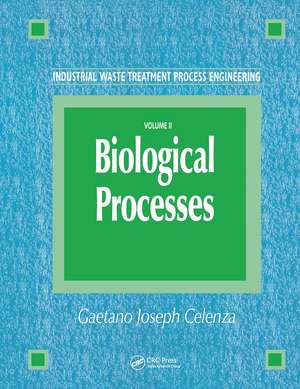Industrial Waste Treatment Process Engineering: Biological Processes, Volume II
Autor Gaetano Celenzaen Limba Engleză Paperback – 2 dec 2019
Industrial Waste Treatment Process Engineering guides experienced engineers through the various steps of industrial liquid and solid waste treatment. The structure of the text allows a wider application to various levels of experience. By beginning each chapter with a simplified explanation of applicable theory, expanding to practical design discussions, and finishing with system Flowsheets and Case Study detail calculations, readers can "enter or leave" a section according to their specific needs. As a result, this set serves as a primer for students engaged in environmental engineering studies AND a comprehensive single-source reference for experienced engineers. Industrial Waste Treatment Process Engineering includes design principles applicable to municipal systems with significant industrial influents. The information presented in these volumes is basic to conventional treatment procedures, while allowing evaluation and implementation of specialized and emerging treatment technologies.
What makes Industrial Waste Treatment Process Engineering unique is the level of process engineering detail. The facility evaluation section includes a step-by-step review of each major and support manufacturing operation, identifying probable contaminant discharges, practical prevention measures, and point source control procedures. This theoretical plant review is followed by procedures to conduct a site specific pollution control program. The unit operation chapters contain all the details needed to complete a treatment process design.
Preț: 253.67 lei
Preț vechi: 439.54 lei
-42% Nou
Puncte Express: 381
Preț estimativ în valută:
48.56€ • 52.76$ • 40.81£
48.56€ • 52.76$ • 40.81£
Carte tipărită la comandă
Livrare economică 21 aprilie-05 mai
Preluare comenzi: 021 569.72.76
Specificații
ISBN-13: 9780367455576
ISBN-10: 0367455579
Pagini: 220
Dimensiuni: 210 x 280 mm
Greutate: 0.45 kg
Ediția:1
Editura: CRC Press
Colecția CRC Press
ISBN-10: 0367455579
Pagini: 220
Dimensiuni: 210 x 280 mm
Greutate: 0.45 kg
Ediția:1
Editura: CRC Press
Colecția CRC Press
Public țintă
ProfessionalCuprins
Introduction, II-1. AERATION, Basic Concepts, Aeration Devices, Process Engineering Design, General Engineering Criteria, Case Study Number, References, II-2. AEROBIC BIOLOGICAL OXIDATION, General Biological Concepts, Factors Sustaining a Biological Reaction, Factors Affecting or Inhibiting a Biological Reaction, Process Variables to Control a Biological System, System Performance, Nitrification and Denitrication, Biological Processes, References, II-3. ACTIVATED SLUDGE SYSTEM, Basics Concepts, Activated Sludge Systems, Process Engineering Design, General Engineering Criteria, Case Study Number 10, Case Study Number 11, Case Study Number 12, Case Study Number 13, References, II-4. BIOLOGICAL OXIDATION: LAGOONS, Basic Concepts, Lagoon Process Evaluations, Process Engineering Design, General Engineering Criteria, Case Study Number 14, Case Study Number 15, References, II-5. BIOLOGICAL OXIDATION: FIXED-FILM PROCESSES, Basic Concepts, Fixed Film Systems, Process Engineering Design, General Engineering Criteria, Case Study Number, Case Study Number, References, II-6. AEROBIC DIGESTION, Basic Concepts, Aerobic Treatment Systems, Process Engineering Design, General Engineering Criteria, Case Study Number 18, References, II-7. ANAEROBIC WASTE TREATMENT—ANAEROBIC SLUDGE DIGESTION, Basic Concepts, Anaerobic Treatment Systems, Process Engineering Design, General Engineering Criteria, Case Study Number 19, Case Study Number 20, References, II-8. SEDIMENTATION, Basic Concepts, Clarification and Thickening Systems, Process Engineering Design, General Engineering Criteria, Case Study Number 21, Case Study Number 22, Case Study Number 23, References, Index
Descriere
Detailing the selection and design of industrial liquid and solid waste treatment systems this book consolidates all the process engineering principles required to evaluate a wide range of industrial facilities, starting with pollution prevention and source control and ending with end-of-pipe treatment technologies. The structure of the text allows
